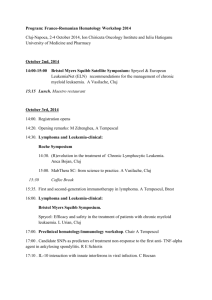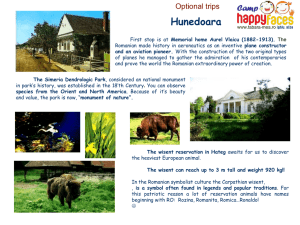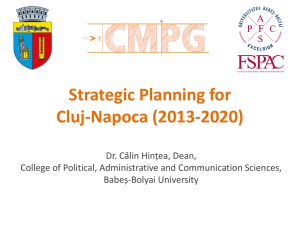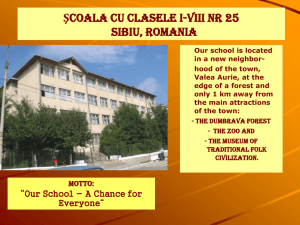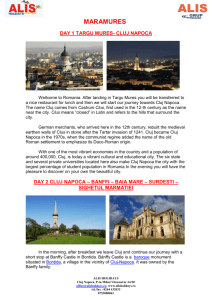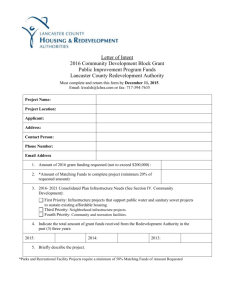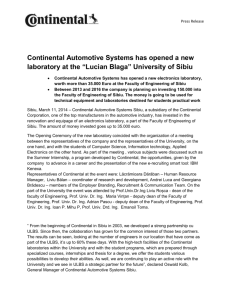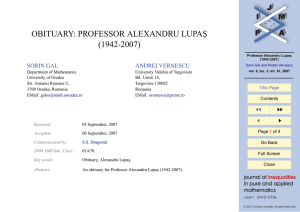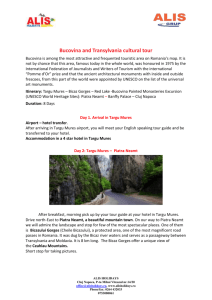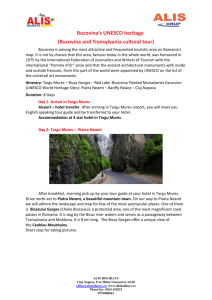Theme of the study abroad program in Cluj: Community
advertisement
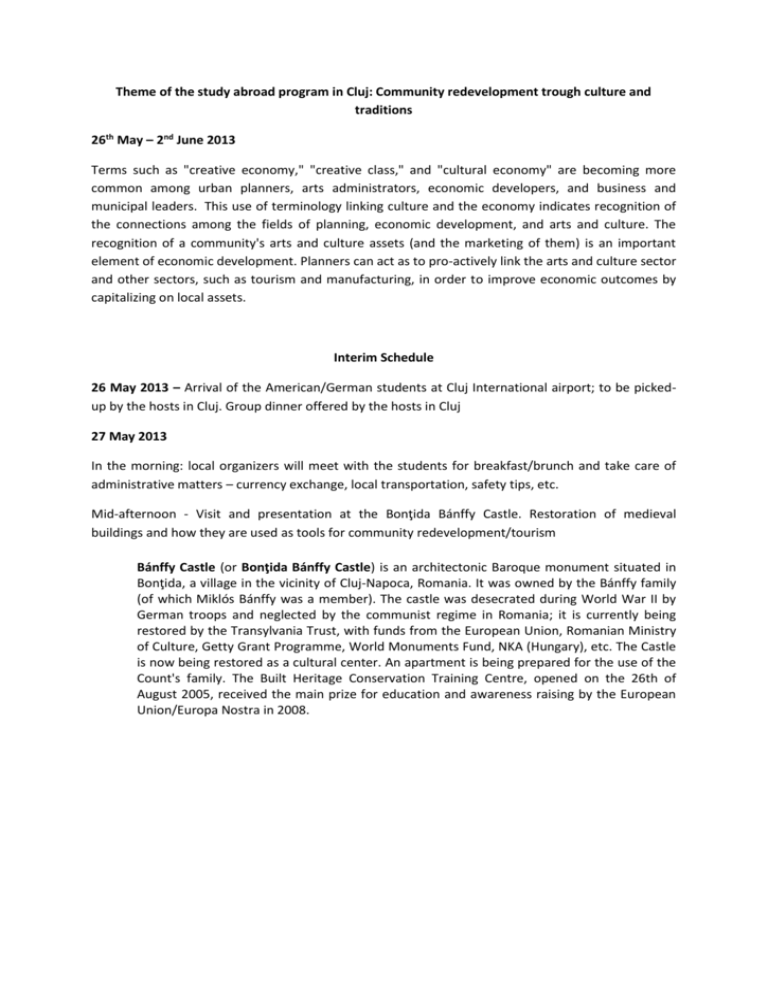
Theme of the study abroad program in Cluj: Community redevelopment trough culture and traditions 26th May – 2nd June 2013 Terms such as "creative economy," "creative class," and "cultural economy" are becoming more common among urban planners, arts administrators, economic developers, and business and municipal leaders. This use of terminology linking culture and the economy indicates recognition of the connections among the fields of planning, economic development, and arts and culture. The recognition of a community's arts and culture assets (and the marketing of them) is an important element of economic development. Planners can act as to pro-actively link the arts and culture sector and other sectors, such as tourism and manufacturing, in order to improve economic outcomes by capitalizing on local assets. Interim Schedule 26 May 2013 – Arrival of the American/German students at Cluj International airport; to be pickedup by the hosts in Cluj. Group dinner offered by the hosts in Cluj 27 May 2013 In the morning: local organizers will meet with the students for breakfast/brunch and take care of administrative matters – currency exchange, local transportation, safety tips, etc. Mid-afternoon - Visit and presentation at the Bonţida Bánffy Castle. Restoration of medieval buildings and how they are used as tools for community redevelopment/tourism Bánffy Castle (or Bonţida Bánffy Castle) is an architectonic Baroque monument situated in Bonţida, a village in the vicinity of Cluj-Napoca, Romania. It was owned by the Bánffy family (of which Miklós Bánffy was a member). The castle was desecrated during World War II by German troops and neglected by the communist regime in Romania; it is currently being restored by the Transylvania Trust, with funds from the European Union, Romanian Ministry of Culture, Getty Grant Programme, World Monuments Fund, NKA (Hungary), etc. The Castle is now being restored as a cultural center. An apartment is being prepared for the use of the Count's family. The Built Heritage Conservation Training Centre, opened on the 26th of August 2005, received the main prize for education and awareness raising by the European Union/Europa Nostra in 2008. Afternoon/Evening- free time. The Romanian students taking part in the study abroad program will suggest several venues/objectives to be visited in Cluj. Group visits can be arranged. 28 May 2013 Proposed visits and presentations in the morning - Strategic urban planning in Cluj – creating the vision for development. The city hall is currently in the process of updating/redrafting their master plan. Meet the people from the city hall. Presentation and discussion about this process; Related topics include spatial development strategies followed by the Cluj city hall under the influence of EU structural funds/regional policy. - Cluj arena – new stadium opened in 2012, it is located in the vicinity of the downtown and seen as a major tool for keeping various performance and sports events within the city. Presentation on financing, impact on local economy, challenges. - TIFF – international film festival that takes place in Cluj every summer, June usually, it is seen as a brand of the city. For a month it generates tremendous cultural activities, related to the festival, and the municipality says it is a great catalyst for all sorts of other event. Also helps the local economy and tourism. Presentation by city hall in partnership with a representative from TIFF - Downtown redevelopment – squares and plazas. In the last years the municipality has concentrated on redeveloping several squares and plazas with an emphasis on giving the city center back to people. These spaces are great outdoor meeting points, lots of coffee houses, restaurants, bars. There are however people who oppose these developments. Presentation by planning department regarding the redevelopment strategy used, limitations, etc. I– visit a rural community. Learn about difficulties encountered in promoting economic growth in the rural area. Romania has a significant rural population and the rural are presents specific challenges for redevelopment – poor infrastructure, aging population, huge disparities between urban/rural, etc. One strategy currently employed is general called social enterprises/social economy. It means that NGOs or other community oriented organizations work with the community toward identifying resources/assets that can be turned into productive capacities. For example there one village that has orchards developed a small fabric that produces natural juices for sale at farmers markets. We will visit such a facility, learn about how ownership is structured – collective ownership, how it helps the local economy, etc. 29 May 2013 In the morning – visit to the Salt mine in Turda; presentation by the city hall on the financing of the project, impact on economic development, plans for the future. The Turda Salt Mine is today a genuine history museum of salt exploitation.The excellent condition of the mining compartments and the equipment used for salt transportation ,as well as the care with which the mine was prepared for touristic use,have turned it into a place of mingled history and legend.The ever higher number of tourists coming here from most various parts of the world to visit the mine are but a confirmation of its historical and touristic value. In the afternoon – free time. Suggested tourist objectives (the Botanical Garden). A walking tour of several working class neighborhoods. They are extremely interesting since they tell the story of the forced industrialization and urbanization that has taken place during the communist regime. It still has long-lasting implication for urban planning today (crowding, lack of amenities such as parks, no parking available, etc.) Dinner – group dinner for all the students at the house of one member of the Public Administration Department (Bogdana) 30-31 May and 1 June 2013 – trip to several medieval towns which are currently being restored and turned into tourist attractions 30 May 2013 – Leave Cluj early in the morning (7.30 am) and go directly to Sighisoara. Visit the town and have a presentation at the city hall about the main cultural events the town hosts throughout the year (the most important is perhaps the Medieval Art festival in the summer) and how they contribute to local community redevelopment. Sighişoara is considered to be the most beautiful and well preserved inhabited citadel in Europe with an authentic medieval architecture. In Eastern Europe, Sighişoara is one of the few fortified towns which are still inhabited. During the 12th century, German craftsmen and merchants known as the Transylvanian Saxons were invited to Transylvania by the King of Hungary to settle and defend the frontier of his realm. By 1337 Sighişoara had become a royal center for the kings, who awarded the settlement urban status in 1367. The city played an important strategic and commercial role at the edges of Central Europe for several centuries. Sighişoara became one of the most important cities of Transylvania, with artisans from throughout the Holy Roman Empire visiting the settlement. The German artisans and craftsmen dominated the urban economy, as well as building the fortifications protecting it. It is estimated that during the 16th and the 17th centuries Sighişoara had as many as 15 guilds and 20 handicraft branches. The Baroque sculptor Elias Nicolai lived in the city. The Wallachian prince Vlad Dracul (father of Vlad the Impaler (Dracula), who lived in exile in the town, let coins to be minted in the city (otherwise coinage was the monopoly of the Hungarian kings in the Kingdom of Hungary) and issued the first document listing the city's Romanian name, Sighişoara. After World War I Sighişoara passed with Transylvania from Austria-Hungary to the Kingdom of Romania. Central Sighişoara has preserved in an exemplary way the features of a small medieval fortified city, it has been listed by the UNESCO as a World Heritage Site. Lunch with the entire group Early afternoon leave for Sibiu. On the way to Sibiu stop at several fortified churches, which are extremely beautiful and well preserved medieval buildings. Within the otherwise relatively poor villages, these churches can represent important assets for tourism and community redevelopment. Most representative one is Biertan (see website in English http://www.biertan.ro/main.php?lang=en) Stay over night near Sibiu. Dinner and hotel accommodations in a traditional house near Sibiu 31 May 2013 – early in the morning (8.00 am) leave for Sibiu. Sibiu was the European cultural capital in 2007. It is a lovely city which had been completely redeveloped for the important event in 2007 (the downtown). Visit the city and have a presentation at the city hall about the importance of being the Europe’s cultural capital. For a detailed description of Sibiu please see in English (http://www.sibiu2007.ro/index_en.php). Lunch with the group in Sibiu Afternoon – free time. Explore the city together with the Romanian students. Suggestion – visit the outdoor museum located just outside of Sibiu. It is a lovely place which has lots of traditional Romanian houses Group dinner 1 June 2013 Leave from Sibiu early in the morning. Stop in Alba Iulia and visit the citadel. The citadel was redeveloped using money from the European Union. There will be a presentation at the city hall. Perhaps it will be interesting for the American students to be provided with a brief overview of how the European Union contributes in its member states to the redevelopment of communities within the framework of the cohesion policy. Good example of public-private partnership. Lunch in Alba Iulia Return to Cluj in the afternoon. 2 June 2013 – leave Cluj.
